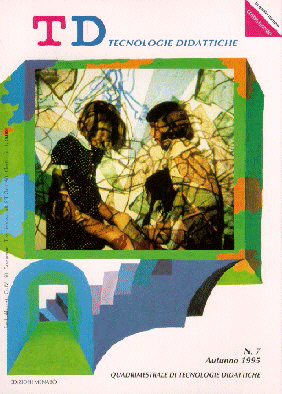Esperimenti in tempo-reale e didattica della fisica
Contenuto principale dell'articolo
Abstract
Dettagli dell'articolo
Gli autori che pubblicano su questa rivista accettano le seguenti condizioni:
- Gli autori mantengono i diritti sulla loro opera e cedono alla rivista il diritto di prima pubblicazione dell'opera, contemporaneamente licenziata sotto una Licenza Creative Commons CC BY 4.0 Attribution 4.0 International License.
- Gli autori possono aderire ad altri accordi di licenza non esclusiva per la distribuzione della versione dell'opera pubblicata (es. depositarla in un archivio istituzionale o pubblicarla in una monografia), a patto di indicare che la prima pubblicazione è avvenuta su questa rivista.
- Gli autori possono diffondere la loro opera online (es. in repository istituzionali o nel loro sito web) prima e durante il processo di submission, poiché può portare a scambi produttivi e aumentare le citazioni dell'opera pubblicata (Vedi The effect of Open Access).
Riferimenti bibliografici
Amodio L. (1992), Balzano E., Bobbio S., Guidoni P, Fusco A, Moretti M., Sassi E., Silvestrini V, Simone P. “Futuro Remoto, Laboratorio di Educazione alla Scienza, Catalogo delle Attività”, Bollettino n.0, CUEN Napoli.
Arons, A.B. (1990): A guide to introductory physics teaching, John Wiley New York.
Balzano E. (1992), P. Guidoni,. M. Moretti, E. Sassi, G. Sgueglia, “Introductory University Courses and Open Environment Approaches: the Computer as a multiRole Mediator in TeachingLearning Physics”, in Intelligent Learning Environments and Knowledge Acquisition in Physics, Nato ASI Series F 86, H. Mandl and A. Tiberghien eds, Springer Verlag, pg. 5 -19.
Balzano E., D’Ajello Caracciolo G., Paolantonio C, Sassi E.(1994). “Attività Didattiche basate su calcolatore per l’integrazione tra Fisica e Matematica nel biennio della Scuola Secondaria Superiore”, La Fisica nella Scuola, 27, pg.161-172.
Carmichael M., Driver R., Holding C. (1993) Research on Students’ Conceptions in Science: A Bibliography, Centre for studies in Science and Mathematics Education, The University, Leeds, UK.
Driver, R. (editor) (1989) International Journal of Science Education, special issue: Student Conceptions in Science vol.11 (5).
Guidoni P, Porro A. and Sassi E. (in press) “Force-Motion Conceptions: a Phenomenological Analysis of Physics Major Freshmen Questionnaires, Proceedings of International Seminar on “Thinking Science for Teaching: the Case of Physics”, Rome 22-27 Sept 94.
Hestenes D., Wells M., and Swackhamer G. (1992) Force Concept Inventory, Physics Teacher, 30, pg. 141-158.
Pfundt H., Duit R. (1993): Bibliography: Students’ alternative frameworks and Science Education . I.P.N. at University of Kiel, Germany.
Sassi E. (1992) “Basic Physics Education and Computer Supported Open Approaches” in Proceedings of TIE, European Conference about Information Technology in Education: a Critical Insight, Universitat de Barcelona, pg. 271-281.
Sassi E. and Balzano E. (1993) “Integration of Basic Physics and Mathematics in Secondary School: a Research/experimentation based on Microcomputer Based Laboratory and Modelling” Proceedings of EPS Conference on The Role of Experiment in Physics Education, Ljubljana: Drustvo matematicov, fisikov in astronomov, pg. 151-163.
Sassi E. and Balzano E. (in press) “Learning and Teaching motion: MBL approaches” in Thinker R. (ed.) Microcomputer Based Labs: Educational Research and Standards, Springer-Verlag.
Thornton R.K. (1990) L’uso del microelaboratore nel laboratorio di fisica per migliorare la comprensione dei concetti. La Fisica nella Scuola, numero speciale su L’elaboratore nella didattica della fisica, vol XXIII, pg. 81-92.
Thornton R.K. (1993) Changing the physics teaching laboratory: using tchnology and new approaches to learning to create an experiential environment for learning physics concepts. Proceedings of EPS Conference on The Role of Experiment in Physics Education, Ljubljana: Drustvo matematicov, fisikov in astronomov, pg. 12-31.
Thornton, R.K. (1987): Tools for Scientific Thinking: Microcomputer Based Laboratories for Physics Teaching, Phys. Educ. 22 (4) pp.230-238.
Thornton, R.K., Sokoloff, D.R.(1990) Learning motion concepts using real-time microcomputer-based laboratory tools Amer. Journ. Phys. 58 (9) pp.858-867.
Viennot L. (1979) Raisonnement spontané en dynamique élémentaire. Hermann, Paris, France Viennot L. (1985) Analysing students’ reasoning in science: A pragmatic view of theoretical problems. European Journal of Science Education, 7, pg. 151-162.

